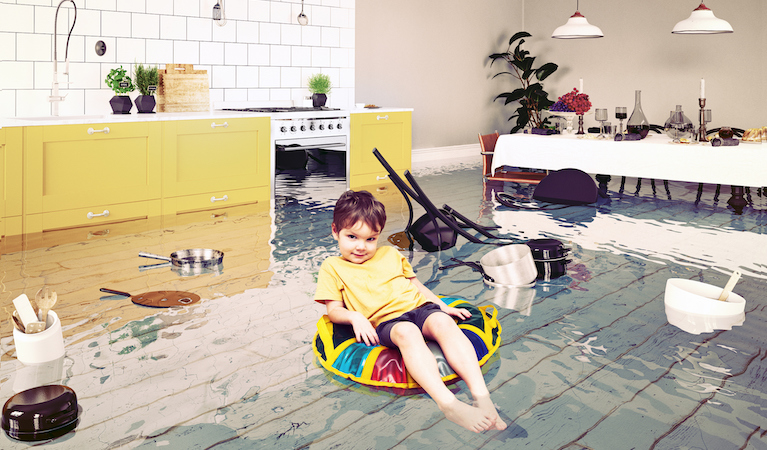We use cookies to improve your experience on our websites and to analyse how and when our sites are used. By clicking 'Accept all & continue' you're agreeing to our use of cookies. To learn more about the cookies we use, you can read our cookie policy.
Opt out of non-essential cookies
From time to time, parts of the UK get flooded, and for a while it is headline news. And as we watch horrifying images of towns, streets, and homes awash with water, in the back of our minds we wonder what we would do in such a situation and how we would cope.
Over the past few years, the amount of flooding in the UK has increased. A lot of this is due to some of the major storms that have hit the country. These storms are thought to be related to climate change, which could further increase the number of homes at risk of flooding in future. Storms cause heavy rainfall and rivers to burst their banks, both of which can lead to flooding in homes.
In addition, various circumstances can cause a flood in an individual home, even if the rest of the neighbourhood is not affected. These are usually plumbing-related, for example:
But if your home does flood for any reason, what should you do?
This article is the latest in an occasional series on how to deal with Domestic Disasters. A list of previous Domestic Disaster articles appears at the end.
In this article we take a look at:
First of all it’s important to know whether or not your home is in a flood zone, which could make it more susceptible to flooding. You can find out if you live in a flood risk area by entering your postcode on the Gov UK website here.
If you are living in a flood risk area it’s important to be prepared for the possibility of flooding, and we will look at that in more detail in the next section.
But as we saw earlier, individual homes can flood for other reasons apart from widespread flooding. So it’s important to carry out regular checks on potential flood hazards in and around your home, and repair or replace damaged items to keep them well maintained. Even if you have to take out a personal loan to do this, it could be well worth it in the long run to avoid your home being damaged by flooding.
Some areas of maintenance to pay particular attention to are:
It is important to understand whether your home insurance covers flooding and what financial help you would get if the worst happened. If your home does flood either due to widespread local flooding or an issue in your home, it is too late to find out that you are not covered by insurance. So take time to check your home insurance and work out what help you would get in a number of different flooding scenarios.
There is an organisation called Flood Re that may be able to help you find additional flood insurance if your home is particularly at risk of flooding. Flood Re is a joint initiative between the Government and insurers, with the aim of making the flood cover part of household insurance policies more affordable. The first thing to do is to use the Flood Re eligibility tool to see if your home might qualify for support. Then, take a look at some of their participating insurers to find a policy that provides the right cover for your situation.
If you live in an area prone to flooding, it is a good idea to sign up for flood alerts at Gov UK so that you will be contacted if there is a problem. You can also keep up to date by calling Floodline on 0345 988 1188, your local radio station and local websites and social media.
If there is a flood warning in your area – particularly a severe flood warning where flooding is deemed a risk and to life and a disruption to the community – you need to take the following actions:
We just referred to “important items”, and a key aspect of being prepared for flooding is to understand what is important. As well as items of sentimental value, there are various official items that you should have with you if at all possible, as they can make things easier later. These include:
It’s also useful to have a small overnight bag ready for each member of the family with basic clothes, toiletries, drinks and snacks in case you need to evacuate.
After widespread local flooding, it’s important not to try and return to your home until you are told by the authorities that it is safe to do so. If there is still flood water this could contain sewage and other hidden dangers, and utilities such as water, electricity and gas may not be able to operate safely. This also applies to any other cause of flooding in your home.
Once it is safe to return, if you are covered by insurance, you will need to contact your insurance company to start the claims process. This usually starts off by a visit from a loss adjustor, who will then assess your claim and let you know how much financial help you are entitled to.
There will then be a long process of restoring your home, during which you will need to get rid of damaged items, and liaise with contractors and utility suppliers to gradually return your home to some kind of normality again.
We hope that this article gives you some useful information about what to do in the event of a flood – or risk of a flood – in your home. If you need some extra money in the early stages of sorting things out, remember that Loans 2 Go offer loans for emergencies that may be able to help.
Previous Domestic Disaster articles include:
For more useful lifestyle and financial tips, visit us here again soon at Loans 2 Go.











© 2024 Loans 2 Go. All rights reserved.